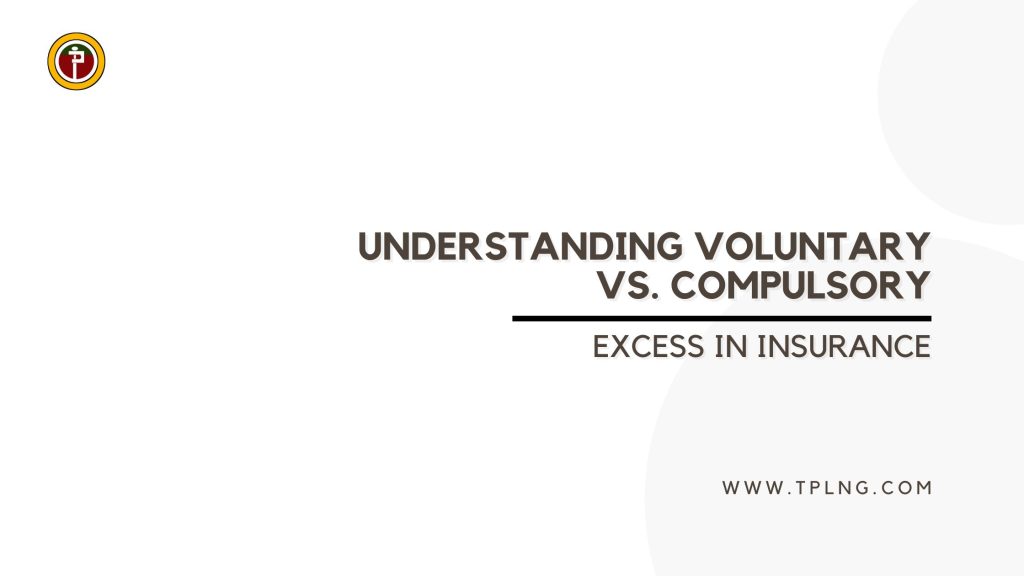When purchasing an insurance policy, many individuals focus on the coverage, premiums, and the claims process, but one key factor that often goes unnoticed is excess. Excess is the amount a policyholder must pay out of pocket when making a claim. It serves as a way to ensure that the insured shares in the cost of a claim, preventing small, unnecessary claims from being made.
Excess can come in two forms: voluntary and compulsory. Both have significant implications on how much you pay for your insurance and how much you’ll need to pay in the event of a claim. In this article, we’ll dive into the difference between voluntary and compulsory excess, and what to consider when choosing your policy.
Also read:
How to Choose the Right Excess Level for Your Insurance Policy
Why is Insurance Unpopular Among Nigerians?
Understanding Excess in Insurance: A Comprehensive Guide
Understanding Insurance Principles: How They Affect Your Insurance Policies
What is Compulsory Excess?
Compulsory excess is the amount an insurer requires you to pay when making a claim. It is non-negotiable and set by the insurance company based on several factors, including the type of insurance, the level of risk associated with the policyholder, and sometimes even the specific coverage being offered.
For example, in motor insurance, compulsory excess might be higher for younger drivers or individuals with a poor driving record, as they are considered higher risk. Similarly, in home insurance, properties located in areas prone to flooding or burglary may have higher compulsory excesses.
Key Points About Compulsory Excess:
- Non-Negotiable: You cannot change or avoid paying compulsory excess when making a claim.
- Set by the Insurer: The amount is determined by the insurer based on the perceived risk.
- Dependent on Risk: If you are deemed a higher-risk policyholder, you will typically face a higher compulsory excess.
What is Voluntary Excess?
On the other hand, voluntary excess is an additional amount that the policyholder agrees to pay on top of the compulsory excess. The idea behind this is that by offering to cover a higher portion of the claim, the policyholder can reduce their premium.
Opting for a higher voluntary excess can be a good option if you are confident that you won’t need to make frequent claims and want to lower your monthly or annual premium. However, it is important to ensure that you can afford the total excess (compulsory + voluntary) if a claim needs to be made.
Key Points About Voluntary Excess:
- Optional: You choose whether or not to add voluntary excess.
- Lowers Premium: A higher voluntary excess often leads to lower premiums.
- Financial Responsibility: You must be confident that you can pay the combined excess amount in the event of a claim.
How Voluntary and Compulsory Excess Work Together
When you make a claim, both compulsory and voluntary excess are added together to determine how much you will pay out of pocket. For example, if your compulsory excess is ₦50,000 and you’ve chosen a voluntary excess of ₦30,000, you will need to pay ₦80,000 in total before your insurance company pays the remainder of the claim.
Let’s consider a practical scenario:
Scenario 1: You have a car insurance policy with a compulsory excess of ₦50,000. You decide to add a voluntary excess of ₦30,000 to lower your premium. One day, you are involved in an accident, and the repair cost for your car is ₦300,000. In this case, you would pay the first ₦80,000 (compulsory + voluntary excess), and the insurer would cover the remaining ₦220,000.
Benefits of Voluntary and Compulsory Excess
Both types of excess come with their own benefits, depending on your financial situation and risk tolerance.
Benefits of Compulsory Excess:
- Risk Sharing: Compulsory excess encourages responsible behavior as policyholders have some financial stake in the outcome of their claims.
- Reduces Insurers’ Costs: By requiring policyholders to contribute to claims, insurers reduce the number of small or frivolous claims, which in turn helps to stabilize premiums for everyone.
- Predictable: Since compulsory excess is set by the insurer, it provides a clear expectation of the minimum amount you will need to pay in the event of a claim.
Benefits of Voluntary Excess:
- Lower Premiums: By agreeing to a higher voluntary excess, you can reduce your monthly or annual premium, helping you save money upfront.
- Greater Control: Voluntary excess allows you to adjust the balance between your premium and how much you are willing to pay out of pocket in the event of a claim.
- Flexibility: You can choose a voluntary excess that matches your financial ability, giving you more control over your insurance costs.
Also read:
How to Choose the Right Excess Level for Your Insurance Policy
Why is Insurance Unpopular Among Nigerians?
Understanding Excess in Insurance: A Comprehensive Guide
Understanding Insurance Principles: How They Affect Your Insurance Policies
Drawbacks of Voluntary and Compulsory Excess
While excess can provide benefits, there are also some downsides to consider.
Drawbacks of Compulsory Excess:
- Higher Costs for High-Risk Individuals: If you are deemed a higher risk, your compulsory excess could be substantial, leading to higher out-of-pocket costs.
- No Flexibility: As a policyholder, you have no control over the compulsory excess amount.
Drawbacks of Voluntary Excess:
- Financial Strain: While adding a voluntary excess can reduce your premiums, it may leave you in a difficult financial position if you need to make a claim and are unable to pay the excess.
- Limited Savings: Sometimes the reduction in premiums may not justify the risk of paying a large voluntary excess if a claim is made. It’s important to carefully calculate the potential savings and weigh them against the increased financial responsibility.
Finally, understanding the difference between voluntary and compulsory excess is crucial when selecting an insurance policy that fits your needs and budget. While a higher voluntary excess can reduce your premium, it’s important to ensure that you can afford the combined total if you need to make a claim.
By carefully considering your financial situation, claims history, and risk tolerance, you can find the right balance between premium savings and manageable out-of-pocket costs.
In the end, insurance is about protecting your financial future, and understanding excess—whether voluntary or compulsory—plays a significant role in how well that protection works for you.
Take advantage of the next article, subscribe now!
Have questions about claim settlements or need assistance with your insurance policy? Our team is here to help! Reach out to us via email at info@tplng.com or give us a call at 0905-776-6182. We’re committed to ensuring genuine claim settlements and supporting our valued members.
TPL, your satisfaction is our priority




